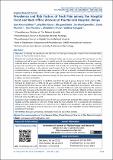| dc.contributor.author | Sore, Kwoma Bilton | |
| dc.contributor.author | Otieno, Wycliffe | |
| dc.contributor.author | Stella, Margaret | |
| dc.contributor.author | Ogwedho, Serafino | |
| dc.contributor.author | Muriithi, David | |
| dc.contributor.author | Munyao, Ann | |
| dc.contributor.author | Muya, Christine K. | |
| dc.contributor.author | Karuguti, Wallace | |
| dc.date.accessioned | 2023-06-13T12:03:37Z | |
| dc.date.available | 2023-06-13T12:03:37Z | |
| dc.date.issued | 2023-06 | |
| dc.identifier.citation | Sore Kwoma Bilton, Wycliffe Otieno, Margaret Stella, Serafino Ogwedho, David Muriithi, Ann Munyao, Christine K Muya, Wallace Karuguti. Prevalence and Risk Factors of Neck Pain among the Hospital Front and Back Office Workers at the Nairobi Hospital, Kenya. Int J Physiother Res 2023;11(3):4498-4507. DOI: 10.16965/ijpr.2023.108 | en_US |
| dc.identifier.issn | 2321-1822 | |
| dc.identifier.uri | https://dx.doi.org/10.16965/ijpr | |
| dc.identifier.uri | https://repository.amref.ac.ke/handle/20.500.14173/840 | |
| dc.description.abstract | Objective: To identify the prevalence and risk factor of neck pain among the hospital front and back-office
workers at The Nairobi Hospital, Kenya.
Material and methods: Descriptive cross-sectional studies was carried out among 133 participants on the
prevalence and risk factors of neck pain at a specific point of time defined by the population. All variables were
collected within a specified duration. An adapted structured close ended questionnaire was used, covering
group-made questions for population parameters and variables, for screening neck status for the enrolled
participants. In addition to the adapted questionnaire from the Oswestry Neck Disability Index (ONDI)
combined with our variables, participants were requested to fill out an adapted combined self-developed questionnaire consisting of demographics characteristics; age, gender, duration of employment, and pain intensity.
Collected data was analyzed using statistical package of social sciences-SPSS version 21, and results tabulated
in tables, pie charts and graphs.
Results: majority of participant ( n=112,84%) were from the age of group between 41-50 years at 42%,
followed by 31-40 years at 37%, 21-30 years at 20% and finally 51 years and above at 1%. Females
represented by 66% and males at 34% of the participants. Period of employment was between 1-10 years at
60% followed by 11-20 years with 34%, less than 1 year and 21-30 years each represented by 3%. workers
currently with neck pain at the Nairobi hospital were (n=38 ,34%). Pain intensity; Majority of those who had
neck pain 25% had mild pain, while only 1% had severe pain. Those with risk factors for sitting durations;
sitting at 2-4hrs represented by 47.3%, followed by 5-6hrs at 37.5%, less than 2 hours was 8.9%, 7-8hrs was
3.6% and more than 8hrs was 2.7%.
Conclusion: study concludes that prevalence of neck pain among front and back-office workers at The Nairobi
Hospital currently accounts for 34% with female being the most affected. This is associated with continuous
sitting and poor body mechanics in relation to work station and equipment. Age, gender, period of
employment, and sitting posture awareness were also found to be important factors influencing the
occurrence of neck pain. | en_US |
| dc.language.iso | en_US | en_US |
| dc.publisher | International Journal of Physiotherapy and Research | en_US |
| dc.subject | Neck pain | en_US |
| dc.subject | prevalence | en_US |
| dc.subject | risk factors | en_US |
| dc.subject | Front and back-office workers | en_US |
| dc.title | Prevalence and Risk Factors of Neck Pain among the Hospital Front and Back Office Workers at the Nairobi Hospital, Kenya | en_US |
| dc.type | Article, Journal | en_US |

